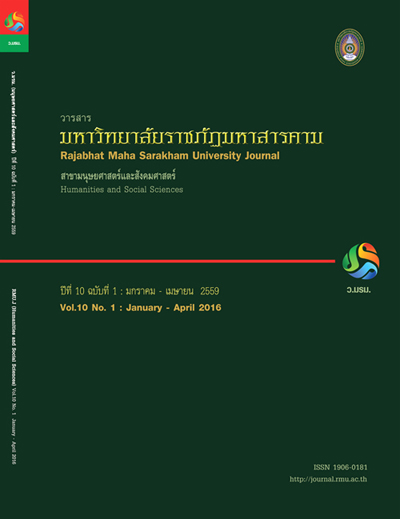การประเมินความแตกต่างประสบการณ์การเรียนรู้ เรื่อง คำและหน้าที่ของคำ ของนักเรียนชั้นประถมศึกษาปีที่ 4 ระหว่างการจัดการเรียนรู้แบบร่วมมือ ด้วยเทคนิค STAD กับการจัดการเรียนด้วยวิธีปกติ; The Assessment of the Differences of Learning Experience between Coopera
Main Article Content
Abstract
การวิจัยครั้งนี้มีวัตถุประสงค์ ประการแรก เพื่อประเมินความแตกต่างประสบการณ์การเรียนรู้ที่เน้นผู้เรียนเป็นสำคัญ เรื่อง คำ
และหน้าที่ของคำของนักเรียนชั้นประถมศึกษาปีที่ 4 ที่เรียนด้วยการจัดการเรียนรู้แบบร่วมมือเทคนิค STAD กับการจัดการเรียนรู้ปกติ
และประการที่สอง เพื่อเปรียบเทียบผลสัมฤทธิ์ทางการเรียนและการคิดวิเคราะห์ เรื่อง คำและหน้าที่ของคำ ของนักเรียนที่เรียน ด้วย
การจัดการเรียนรู้แบบร่วมมือด้วยเทคนิค STAD กับการจัดการเรียนรู้ด้วยวิธีปกติ กลุ่มตัวอย่างเป็นนักเรียนชั้นประถมศึกษาปีที่ 4
ภาคเรียนที่ 2 ปีการศึกษา 2554 โรงเรียนอนุบาลเมืองเสลภูมิ สำนักงานเขตพื้นที่การศึกษาประถมศึกษาร้อยเอ็ด เขต 3 จำนวน 2
ห้องเรียน 60 คน ได้จากการสุ่มแบบยกกลุ่ม (Cluster random sampling) เครื่องมือที่ใช้ในการวิจัย ได้แก่ 1) แผนการจัดการเรียน
รู้แบบร่วมมือเทคนิค STAD 2) แผนการจัดการเรียนรู้ด้วยวิธีปกติ 3) แบบประเมินประสบการณ์การเรียนรู้ที่เน้นผู้เรียนเป็นสำคัญ 4)
แบบทดสอบวัดผลสัมฤทธิ์ทางการเรียนวิชาภาษาไทย เรื่อง คำและหน้าที่ของคำ จำนวน 30 ข้อ มีค่าความยาก ตั้งแต่ 0.24-0.78 ค่า
อำนาจจำแนก ตั้งแต่ 0.31 - 0.85 ค่าความเชื่อมั่น 0.93 และ 5) แบบวัดการคิดวิเคราะห์ จำนวน 30 ข้อ มีค่าความยาก ตั้งแต่ 0.32-
0.76 ค่าอำนาจจำแนก ตั้งแต่ 0.34 -0.72 ค่าความเชื่อมั่น 0.86 สถิติที่ใช้ในการวิเคราะห์ข้อมูล ได้แก่ ความถี่ ร้อยละ ค่าเฉลี่ย ส่วน
เบี่ยงเบนมาตรฐาน การทดสอบยู ของแมนน์-วิทนีย์ และโฮเทลลิง ทีกำลังสอง ผลการวิจัยพบว่า
1. นักเรียนที่ได้รับการจัดการเรียนรู้ เรื่อง คำและหน้าที่ของคำ ด้วยการจัดการเรียนรู้แบบร่วมมือด้วยเทคนิค STAD
มีประสบการณ์การเรียนรู้ที่เน้นผู้เรียนเป็นสำคัญสูงกว่านักเรียนที่ได้รับการจัดการเรียนรู้ปกติ อย่างมีนัยสำคัญทางสถิติที่ระดับ .01
2. นักเรียนที่ได้รับการจัดการเรียนรู้ เรื่อง คำและหน้าที่ของคำ ด้วยการจัดการเรียนรู้แบบร่วมมือด้วยเทคนิค STAD มีผล
สัมฤทธิ์ทางการเรียนและการคิดวิเคราะห์หลังเรียน สูงกว่านักเรียนที่ได้รับการจัดการเรียนรู้ปกติ อย่างมีนัยสำคัญทางสถิติที่ระดับ .01
The Objectives of this research were (1) assess to the differences of child-centered learning experience
between Cooperative Learning - STAD technique and traditional about “word and part of speech” for grade 4
students, and (2) to compare learning achievement and analytic thinking of grade 4 students about “word and
part of speech” based on STAD Cooperative Learning Method to normal leaning method. The samples were
selected by cluster random sampling; 60 grade 4 students from 2 classes of Anuban Muang Selaphum School,
Roi-et Primary Educational Service Area Office 3, in the second semester of the academic year 2011. The
research instruments consisted of 1) evaluation form of child-centered learning experience, 2) STAD Cooperative
Learning Method lesson plans, 3) Normal Learning Method lesson plans, 4) Thai language learning achievement
tests about “word and part of speech” which resulted difficulty 0.24 -0.78, discrimination 0.31-0.85, reliability
0.93 5) and critical thinking tests which resulted difficulty 0.32-0.76, discrimination 0.34-0.72, reliability 0.86.
The statistics used in data analysis included mean, standard deviation, the t-test (Independent Sample), Mann-
Whitney U Test, and Hotelling T2.
The findings were as follows:
1. Learning achievement about “word and part of speech” of the students taught through STAD
Cooperative Learning Method gained more child-centered learning experience than the students taught through
Normal Learning Method. The statistical significant level was .01.
2. The achievement scores about “word and part of speech” of the students taught through STAD
Cooperative Learning Method were higher than the scores of the students taught through Normal Learning
Method. The statistical significant level was .01
Article Details
1. All articles undergo a thorough with at least three reviewers evaluating their suitability within the respective field of study, during the double-blind review.
2. The views expressed by individual authors do not represent the official views of the Editorial Boards of RMUJ: The author of each articie is responsible for all its contents.
3. The Editorial Boards do not reserve the copyrights. but proper citations need to be made.


